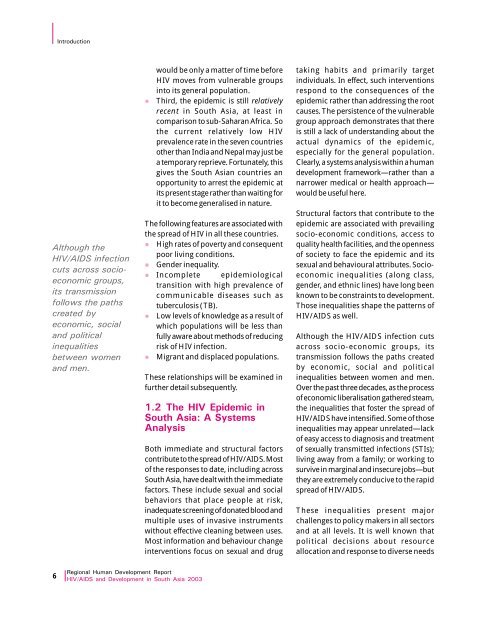Download Report - UNDP Asia-Pacific Regional Centre - United ...
Download Report - UNDP Asia-Pacific Regional Centre - United ...
Download Report - UNDP Asia-Pacific Regional Centre - United ...
Create successful ePaper yourself
Turn your PDF publications into a flip-book with our unique Google optimized e-Paper software.
IntroductionAlthough theHIV/AIDS infectioncuts across socioeconomicgroups,its transmissionfollows the pathscreated byeconomic, socialand politicalinequalitiesbetween womenand men.lwould be only a matter of time beforeHIV moves from vulnerable groupsinto its general population.Third, the epidemic is still relativelyrecent in South <strong>Asia</strong>, at least incomparison to sub-Saharan Africa. Sothe current relatively low HIVprevalence rate in the seven countriesother than India and Nepal may just bea temporary reprieve. Fortunately, thisgives the South <strong>Asia</strong>n countries anopportunity to arrest the epidemic atits present stage rather than waiting forit to become generalised in nature.The following features are associated withthe spread of HIV in all these countries.l High rates of poverty and consequentpoor living conditions.l Gender inequality.l Incomplete epidemiologicaltransition with high prevalence ofcommunicable diseases such astuberculosis (TB).l Low levels of knowledge as a result ofwhich populations will be less thanfully aware about methods of reducingrisk of HIV infection.l Migrant and displaced populations.These relationships will be examined infurther detail subsequently.1.2 The HIV Epidemic inSouth <strong>Asia</strong>: A SystemsAnalysisBoth immediate and structural factorscontribute to the spread of HIV/AIDS. Mostof the responses to date, including acrossSouth <strong>Asia</strong>, have dealt with the immediatefactors. These include sexual and socialbehaviors that place people at risk,inadequate screening of donated blood andmultiple uses of invasive instrumentswithout effective cleaning between uses.Most information and behaviour changeinterventions focus on sexual and drugtaking habits and primarily targetindividuals. In effect, such interventionsrespond to the consequences of theepidemic rather than addressing the rootcauses. The persistence of the vulnerablegroup approach demonstrates that thereis still a lack of understanding about theactual dynamics of the epidemic,especially for the general population.Clearly, a systems analysis within a humandevelopment framework—rather than anarrower medical or health approach—would be useful here.Structural factors that contribute to theepidemic are associated with prevailingsocio-economic conditions, access toquality health facilities, and the opennessof society to face the epidemic and itssexual and behavioural attributes. Socioeconomicinequalities (along class,gender, and ethnic lines) have long beenknown to be constraints to development.Those inequalities shape the patterns ofHIV/AIDS as well.Although the HIV/AIDS infection cutsacross socio-economic groups, itstransmission follows the paths createdby economic, social and politicalinequalities between women and men.Over the past three decades, as the processof economic liberalisation gathered steam,the inequalities that foster the spread ofHIV/AIDS have intensified. Some of thoseinequalities may appear unrelated—lackof easy access to diagnosis and treatmentof sexually transmitted infections (STIs);living away from a family; or working tosurvive in marginal and insecure jobs—butthey are extremely conducive to the rapidspread of HIV/AIDS.These inequalities present majorchallenges to policy makers in all sectorsand at all levels. It is well known thatpolitical decisions about resourceallocation and response to diverse needs6<strong>Regional</strong> Human Development <strong>Report</strong>HIV/AIDS and Development in South <strong>Asia</strong> 2003
















